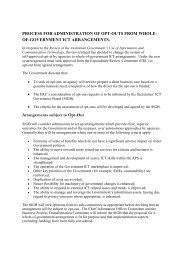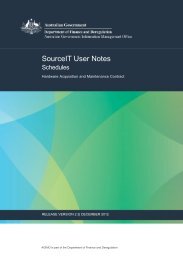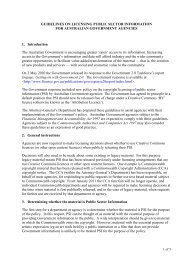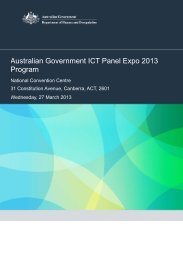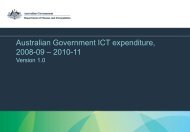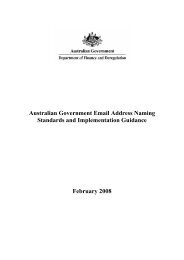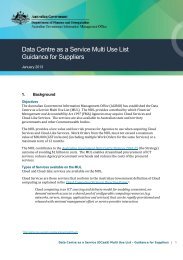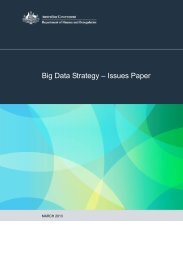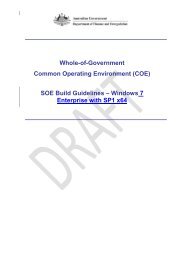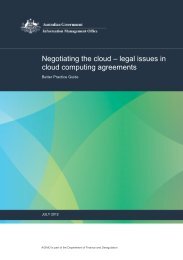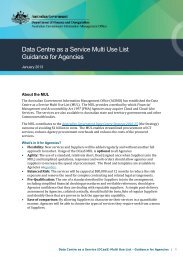Email Protective Marking Standard for the Australian Government
Email Protective Marking Standard for the Australian Government
Email Protective Marking Standard for the Australian Government
Create successful ePaper yourself
Turn your PDF publications into a flip-book with our unique Google optimized e-Paper software.
<strong>Email</strong> <strong>Protective</strong> <strong>Marking</strong> <strong>Standard</strong><strong>for</strong> <strong>the</strong> <strong>Australian</strong> <strong>Government</strong>| AUGUST 2012 (VERSION 2012.3)
DisclaimerThis document has been prepared by <strong>the</strong> Department of Finance and Deregulation (Finance)in consultation with industry and o<strong>the</strong>r agencies, including <strong>the</strong> Attorney-General’s Departmentand <strong>the</strong> Defence Signals Directorate (DSD) to provide in<strong>for</strong>mation to government bodies inrelation to <strong>the</strong> use of email within <strong>the</strong> <strong>Australian</strong> <strong>Government</strong>.This document and <strong>the</strong> in<strong>for</strong>mation contained herein are provided on an “as is” basis and <strong>the</strong>contributors and <strong>the</strong> organisations <strong>the</strong>y represent and are sponsored by disclaim allwarranties, express or implied, including but not limited to any warranty that <strong>the</strong> use of <strong>the</strong>in<strong>for</strong>mation herein will not infringe any rights or any implied warranties of merchantability orfitness <strong>for</strong> a particular purpose.Links to o<strong>the</strong>r websites are inserted <strong>for</strong> convenience only and do not constitute endorsementof material at those sites, or any associated organisation, product or service.© Commonwealth of Australia 2012ISBN 978-1-922096-05-0 onlineApart from any use permitted under <strong>the</strong> Copyright Act 1968, and <strong>the</strong> rights explicitly grantedbelow, all rights are reserved.You are free to copy, distribute and transmit <strong>the</strong> work as long as you attribute <strong>the</strong> authors. Youmay not use this work <strong>for</strong> commercial purposes. You may not alter, trans<strong>for</strong>m, or build uponthis work.Except where o<strong>the</strong>rwise noted, any reference to, reuse or distribution of all or part of thisreport must include <strong>the</strong> following attribution:<strong>Email</strong> <strong>Protective</strong> <strong>Marking</strong> <strong>Standard</strong> <strong>for</strong> <strong>the</strong> <strong>Australian</strong> <strong>Government</strong>, Copyright <strong>Australian</strong><strong>Government</strong> 2012.Licence: This document is licensed under a Creative Commons Attribution Non-Commercial NoDerivs 3.0 licence.To view a copy of this licence, visit: http://creativecommons.org/licenses/by-ncnd/3.0/legalcode.Any of <strong>the</strong> above conditions can be waived if you get our permission. Requests <strong>for</strong> permissionshould be addressed in <strong>the</strong> first instance to au<strong>the</strong>ntication@finance.gov.auCOMPLIANCE WITH THE PSPF AND THE ISMThe <strong>Email</strong> <strong>Protective</strong> <strong>Marking</strong> <strong>Standard</strong> <strong>for</strong> <strong>the</strong> <strong>Australian</strong> <strong>Government</strong> Version 2012.3 (August2012) has been developed to assist agencies implement email protective markings.Compliance with this document will assist agencies manage and protect <strong>Australian</strong><strong>Government</strong> in<strong>for</strong>mation in accordance with <strong>the</strong> protective marking requirements of <strong>the</strong><strong>Australian</strong> <strong>Government</strong> <strong>Protective</strong> Security Policy Framework (PSPF) and <strong>the</strong> <strong>Australian</strong><strong>Government</strong> In<strong>for</strong>mation Security Manual (ISM).The ISM, issued by DSD, stipulates that agencies must comply with this <strong>Standard</strong>.2
AbstractThis <strong>Standard</strong> defines <strong>the</strong> <strong>for</strong>mat of protective markings <strong>for</strong> Internet email messageheaders used <strong>for</strong> messages exchanged within and between <strong>Australian</strong> <strong>Government</strong>agencies. A protective marking conveys <strong>the</strong> protection requirements <strong>for</strong> in<strong>for</strong>mation ina message, as defined within <strong>the</strong> <strong>Australian</strong> <strong>Government</strong> <strong>Protective</strong> Security PolicyFramework. The protective marking may also contain additional in<strong>for</strong>mation about <strong>the</strong>message that tells systems and system users how to appropriately disseminate <strong>the</strong>in<strong>for</strong>mation contained in <strong>the</strong> message.Fur<strong>the</strong>r in<strong>for</strong>mation on protectively marking and handling sensitive and securityclassified in<strong>for</strong>mation can be found at: <strong>Protective</strong>ly marking and handling sensitive andsecurity classified in<strong>for</strong>mation [DOC 793KB] 1SummaryAttributeSubject Line(count)Internet MessageHeader Extension(count)Content<strong>for</strong>matDefined Basis /ReferenceVER 0 1 Fixed 2.11.13 This<strong>Standard</strong>NS 0 1 Fixed 2.11.12 PSPFSEC 0..1 0..1 Fixed set 2.11.4 PSPF, MTEE,This<strong>Standard</strong>DLM 0..1 0..1 Fixed set 0 PSPFCAVEAT 0..n 0..n Fixed set& freetext2.11.6 PSPF, MTEEEXPIRESDOWNTO0..1 0..1Fixed<strong>for</strong>mat 2.11.7 PSPFFixed setNOTE 0 0..1 Free text 2.11.10 PSPFORIGIN 0 1 Fixed<strong>for</strong>mat2.11.11 PSPF1 http://www.ag.gov.au/Documents/<strong>Australian</strong>%20<strong>Government</strong>%20in<strong>for</strong>mation%20security%20management%20guidelines%20-%20<strong>Protective</strong>ly%20marking%20and%20handling%20sensitive_1678.pdf3
ContentsAbstract 3Summary 31. Introduction 61.1 Document Terminology and Conventions 61.2 Audience 71.3 Pre- and co-requisite reading 71.4 Assumptions 72. The standard 82.1 Scope 82.2 Out of Scope 82.3 Version 82.4 Namespace 92.5 Syntax of <strong>the</strong> <strong>Protective</strong> <strong>Marking</strong> 92.6 Internet Message Header Extension 102.7 Syntax Precedence and Quantities 102.8 Size of <strong>Protective</strong> <strong>Marking</strong> 102.9 Syntax Definitions 102.10 Regular Expression Definition 112.11 Augmented BNF Definition 153. References 224. Glossary 235. Appendix A 255.1 Change Log 25Changes from 2012.2 25Changes from 2012.1 25Changes from 2011.1 254
Changes from Version 1.0 26Changes from 2005.6 26Changes from 2005.5 26Changes from 2005.4 26Changes from 2005.3 27Changes from 2005.2 27Changes from 2005.1 275.2 Conventions used in this document 286. Appendix B 296.1 Examples 296.2 Subject Line Examples 296.3 Internet Message Header Extension Examples 306.3 Internet Message Header Extension Examples 315
1. IntroductionOfficial in<strong>for</strong>mation generated by <strong>the</strong> <strong>Australian</strong> <strong>Government</strong> must be protected fromunauthorised disclosure. <strong>Protective</strong> security requirements <strong>for</strong> <strong>the</strong> <strong>Australian</strong><strong>Government</strong> are detailed in <strong>the</strong> <strong>Protective</strong> Security Policy Framework (PSPF). Within<strong>the</strong> PSPF, <strong>the</strong> <strong>Australian</strong> <strong>Government</strong> In<strong>for</strong>mation Security Management Protocol [1]describes how official in<strong>for</strong>mation is to be protected. The <strong>Australian</strong> <strong>Government</strong>security classification system [2] gives guidance in identifying and grading <strong>the</strong>confidentiality requirements of official in<strong>for</strong>mation, including when and how to apply aprotective marking so that all those who handle it can apply <strong>the</strong> correct protectivemeasures relating to <strong>the</strong> in<strong>for</strong>mation.This <strong>Standard</strong> defines how such protective markings are to be <strong>for</strong>matted <strong>for</strong> emailmessages.This <strong>Standard</strong> will allow systems, such as an agency’s email gateway, to control <strong>the</strong>flow of in<strong>for</strong>mation into and out of <strong>the</strong> agency. For message recipients it also identifieswhe<strong>the</strong>r an email requires special handling measures by virtue of confidentiality orlegislation.This <strong>Standard</strong> defines two ways in which protective markings can be applied to emailmessages:1. appending <strong>the</strong> protective marking to <strong>the</strong> Subject field using a specified syntax2. including <strong>the</strong> protective marking in an Internet Message Header Extension using aspecified syntax.These are basic syntaxes and are easy to implement in sending and receiving emailagents.Fur<strong>the</strong>r advice in relation to implementation of this <strong>Standard</strong> can be found in <strong>the</strong> <strong>Email</strong><strong>Protective</strong> <strong>Marking</strong> <strong>Standard</strong> – Implementation Guide <strong>for</strong> <strong>the</strong> <strong>Australian</strong> <strong>Government</strong>.1.1 Document Terminology and ConventionsThe keywords “MUST”, “MUST NOT”, “REQUIRED”, “SHALL”, “SHALL NOT”, “SHOULD”,“SHOULD NOT”, “RECOMMENDED”, “MAY”, and “OPTIONAL” in this document are tobe interpreted as described in RFC2119 [3].6
1.2 AudienceThis <strong>Standard</strong> is intended <strong>for</strong> in<strong>for</strong>mation technology professionals involved in <strong>the</strong>development, configuration or administration of email infrastructure components usedby <strong>Australian</strong> <strong>Government</strong> agencies.This <strong>Standard</strong> may have some relevance to in<strong>for</strong>mation technology professionals whodevelop, configure or administer <strong>the</strong> email infrastructures of non-governmentorganisations who exchange messages with <strong>Australian</strong> <strong>Government</strong> agencies. Theseorganisations may wish to exchange email messages with government agencies thatcontain protective markings compliant with this <strong>Standard</strong>.1.3 Pre- and co-requisite readingThis <strong>Standard</strong> should be read in conjunction with RFC2822 [4]. This <strong>Standard</strong> utilisesin<strong>for</strong>mation in RFC2822 wherever possible. Ideally, <strong>the</strong> reader should also be familiarwith <strong>the</strong> Augmented Backus-Naur Form syntax, as defined in RFC2234 [5].The <strong>Standard</strong> relies on concepts and definitions promulgated in <strong>the</strong> <strong>Australian</strong><strong>Government</strong> In<strong>for</strong>mation Security Management Protocol.The <strong>Australian</strong> <strong>Government</strong> Recordkeeping Metadata <strong>Standard</strong> version 2.0, July 2008(AGRkMS) [6] sets out <strong>the</strong> type of in<strong>for</strong>mation that agencies should capture in astructured way to describe <strong>the</strong> identity, au<strong>the</strong>nticity, content, structure, context andessential management requirements of records and includes a standard set ofmetadata <strong>for</strong> use with email messages. Agencies are also referred to <strong>the</strong> AGRkMSImplementation Guidance (June 2011) prepared by <strong>the</strong> National Archives of Australia.1.4 AssumptionsThe assumptions made by this <strong>Standard</strong> are that:• <strong>the</strong> message <strong>for</strong>mat used by <strong>the</strong> communicating parties is RFC2822 2• email receiving agents will not experience fatal software exceptions on receipt ofa message with an arbitrarily long Subject field 3• email receiving agents will not experience fatal software exceptions on receipt ofa message with an Internet Message Header Extension field.2 This does not mean <strong>the</strong> message necessarily was transmitted over <strong>the</strong> Internet, only that it uses <strong>the</strong> RFC2822 standard <strong>for</strong> <strong>for</strong>matting <strong>the</strong>email message.3 The agents may not be able to display arbitrarily long Subject fields but such Subject fields will not cause a software exception in <strong>the</strong>m.7
2. The standard2.1 ScopeThis <strong>Standard</strong> defines <strong>the</strong> <strong>for</strong>mat of protective markings in Internet email message(RFC2822) headers.This <strong>Standard</strong> is mandatory <strong>for</strong> <strong>Australian</strong> <strong>Government</strong> agencies as defined in <strong>the</strong> PSPFand optional <strong>for</strong> non-government agencies. Specific compliance requirements <strong>for</strong> agenciesare outlined in <strong>the</strong> <strong>Australian</strong> <strong>Government</strong> In<strong>for</strong>mation Security Manual (ISM) [7].2.2 Out of ScopeThe following topics are not addressed by this <strong>Standard</strong>:• How a sending or receiving email agent should behave when creating or receivingan email message. This behaviour is defined in <strong>the</strong> ISM.• The protective measures that need to be applied to an email message based on itsprotective marking. The PSPF and <strong>the</strong> ISM define <strong>the</strong> protective measures to betaken based on <strong>the</strong> protective marking of <strong>the</strong> in<strong>for</strong>mation.• The <strong>for</strong>mat of <strong>the</strong> protective marking when <strong>the</strong> marking is part of <strong>the</strong> body of anemail message.• The <strong>for</strong>mat of <strong>the</strong> protective marking when <strong>the</strong> marking is a digitally signedattribute of <strong>the</strong> message.• Differentiation between protective markings <strong>for</strong> whole messages or differentprotective markings <strong>for</strong> parts or components of messages, including attachmentsand paragraphs. The protective marking is used to indicate <strong>the</strong> highest protectionrequirements of any part or component of <strong>the</strong> email message.2.3 VersionThe version number <strong>for</strong> this definition of <strong>the</strong> <strong>Standard</strong> is:2012.378
2.4 NamespaceThe protective markings described in this <strong>Standard</strong> use <strong>the</strong> security classificationsystem defined in <strong>the</strong> <strong>Australian</strong> <strong>Government</strong> security classification system.The syntaxes defined in this <strong>Standard</strong> contain elements to convey this namespace. Thenamespace <strong>for</strong> this <strong>Standard</strong> is:gov.au• This namespace value does not necessarily reflect <strong>the</strong> email domain of <strong>the</strong> sendingand receiving parties. It is simply a short and convenient string that has been usedto differentiate this namespace from ano<strong>the</strong>r entity’s.• If an <strong>Australian</strong> State or Territory government agency wishes to use <strong>the</strong> Federal<strong>Government</strong> namespace and terms <strong>the</strong>n it can use <strong>the</strong> above. If <strong>the</strong> state agencywishes to define and use its own namespace and rules, <strong>the</strong>n it may do so provided ituses a different namespace value.2.5 Syntax of <strong>the</strong> <strong>Protective</strong> <strong>Marking</strong>This <strong>Standard</strong> specifies two ways in which <strong>the</strong> protective marking can be applied to anemail message: Subject Field <strong>Marking</strong> Internet Message Header Extension.The Internet Message Header Extension SHOULD be used in preference to <strong>the</strong> SubjectField <strong>Marking</strong> (see <strong>the</strong> Implementation Guide <strong>for</strong> fur<strong>the</strong>r in<strong>for</strong>mation).2.5.1 Subject Field <strong>Marking</strong>In this syntax <strong>the</strong> protective marking is placed in <strong>the</strong> Subject field of <strong>the</strong> message (RFC2822“Subject”).• This approach is <strong>the</strong> least sophisticated of <strong>the</strong> techniques and is purposely designed so thata human user can construct and interpret <strong>the</strong> protective marking without <strong>the</strong> need <strong>for</strong>additional tools. <strong>Email</strong> gateways should be able to translate <strong>the</strong> email’s subject betweeninternal and Internet <strong>for</strong>mats without any degradation. The syntax is sufficiently rich so anemail agent, or extensions <strong>the</strong>reof, can include or parse <strong>the</strong> protective marking in anautomated fashion. The overloading of <strong>the</strong> “Subject:” header could interfere with o<strong>the</strong>r usesof <strong>the</strong> Subject field. Fur<strong>the</strong>rmore, entry of this in<strong>for</strong>mation by a human is prone to error, andcould be easily misinterpreted by email systems. The approach is also included because it isbackwards compatible with all Internet email agents and systems.• Agencies SHOULD position <strong>the</strong> <strong>Protective</strong> <strong>Marking</strong> at <strong>the</strong> end of <strong>the</strong> Subject field.• Agencies SHOULD, where possible, implement mitigation strategies to minimise <strong>the</strong> risk of<strong>the</strong> <strong>Protective</strong> <strong>Marking</strong> being truncated from <strong>the</strong> end of <strong>the</strong> subject line.Note that during message generation and transport, o<strong>the</strong>r agents may manipulate <strong>the</strong> subject.9
2.6 Internet Message Header ExtensionIn this syntax <strong>the</strong> protective marking is carried as a custom Internet Message HeaderExtension “X-<strong>Protective</strong>-<strong>Marking</strong>”.• This approach is a more sophisticated technique that is an extension of <strong>the</strong> Subjectfield syntax. It is designed <strong>for</strong> construction and parsing by email agents (clients,gateways and servers) as <strong>the</strong>y have access to Internet message headers. In thisway a richer syntax can be used and email agents can per<strong>for</strong>m more complexhandling based on <strong>the</strong> protective marking.2.7 Syntax Precedence and QuantitiesBoth techniques MAY be used in a single email message so long as <strong>the</strong> protectivemarking is consistent across both.When a message contains both <strong>for</strong>ms of <strong>the</strong> protective marking, in<strong>for</strong>mation in <strong>the</strong> “X-<strong>Protective</strong>-<strong>Marking</strong>” SHALL take precedence over that in <strong>the</strong> Subject field.As per RFC2882, an Internet email message can have at most one Subject field.A message con<strong>for</strong>ming to this <strong>Standard</strong> MUST contain at most one “X-<strong>Protective</strong>-<strong>Marking</strong>” field.An email protective marking writer SHALL allow no more than one email protectivemarking in <strong>the</strong> subject line.2.7.1 Non-Compliant <strong>Marking</strong>sWhen a reader encounters an email with multiple protective markings in aSubject line, precedence SHALL be given to <strong>the</strong> first protective marking in <strong>the</strong>subject line. "First" means "leftmost" when reading left-to-right.2.8 Size of <strong>Protective</strong> <strong>Marking</strong>The protective marking, in ei<strong>the</strong>r Subject or Internet Message Header Extension <strong>for</strong>m,MUST NOT exceed a length of 8192 ASCII characters.• In principle, a protective marking may contain a number of DLMs/caveats. Thiscould provide a means <strong>for</strong> attackers to cause resource exhaustion on receivingagents. In practice, <strong>the</strong> length of protective marking will be bounded to somereasonable size which accommodates all current and future possible values. Thesize constraint given here should accommodate such values and thus minimiseavenues of attack.2.9 Syntax DefinitionsThe syntax <strong>for</strong> each protective marking is defined using two methods. A modifiedregular expression syntax using a <strong>for</strong>mat derived from script language regularexpressions and a <strong>for</strong>mal syntax using <strong>the</strong> Augmented Backus-Naur Form (ABNF)notation as used by RFC2822.If <strong>the</strong>re are any ambiguities arising from <strong>the</strong> two syntaxes <strong>the</strong>n <strong>the</strong> ABNF syntax SHALLbe definitive.10
2.10 Regular Expression DefinitionThe modified regular expression syntax of <strong>the</strong> protective marking, when it appears in<strong>the</strong> Subject field, is:[(SEC=|DLM=|SEC=,DLM=)(, CAVEAT=:)*(,EXPIRES=(|), DOWNTO=)?]The modified regular expression syntax of <strong>the</strong> protective marking, when it appears asan Internet Message Header Extension is:X-<strong>Protective</strong>-<strong>Marking</strong>: VER=, NS=gov.au,(SEC=|DLM=|SEC=,DLM=)(, CAVEAT=:)*(,EXPIRES=(|), DOWNTO=)?(,NOTE=)?, ORIGIN=For both of <strong>the</strong> above definitions:• ( )? delimits an optional element that MAY appear only once if used; <strong>the</strong> bracketsand question mark do not actually appear if element is used.• ( )* delimits an optional element that MAY be repeated any number of times; <strong>the</strong>brackets and star symbol do not actually appear if element is used.• denotes <strong>the</strong> variable value of an element; <strong>the</strong> angle brackets do not actuallyappear if <strong>the</strong> value is present. Any character in text may be preceded with ‘\’; <strong>the</strong>following characters must be preceded with ‘\’: ‘\’ and ‘,’ only printable charactersare permitted (see ABNF definitions <strong>for</strong> more detail).• (a|b) denotes an OR option whe<strong>the</strong>r ei<strong>the</strong>r a or b can be used, but not both. Thebrackets and bar symbol do not actually appear if element is used.• The order of elements shown here is important – elements, if present, MUSTappear in <strong>the</strong> order specified.• Field names and values are case-sensitive.• The security classification value used with <strong>the</strong> DOWNTO tag MUST be less thanthat of <strong>the</strong> SEC tag. The hierarchy of security classifications is outlined in <strong>the</strong><strong>Australian</strong> <strong>Government</strong> security classification system.• corresponds to <strong>the</strong> <strong>Australian</strong> <strong>Government</strong> securityclassification system and two additional markings introduced specifically <strong>for</strong> emailmessages, and is one of:o UNOFFICIAL 4o UNCLASSIFIED 5o PROTECTEDo CONFIDENTIALo SECRETo TOP-SECRET4 UNOFFICIAL is not a security classification marking in <strong>the</strong> <strong>Australian</strong> <strong>Government</strong> security classification system. It is included in this <strong>Standard</strong> toallow those agencies that choose to use it a way of distinguishing non work-related email on <strong>the</strong>ir systems.5 UNCLASSIFIED is not a security classification in <strong>the</strong> <strong>Australian</strong> <strong>Government</strong> security classification system. It is included in this <strong>Standard</strong> in orderto allow agencies to recognise work-related emails that do not carry a security classification or o<strong>the</strong>r protective marking.11
• Hyphens have been explicitly added to some of <strong>the</strong>se <strong>for</strong>ms in contrast to <strong>the</strong>ir <strong>for</strong>min <strong>the</strong> PSPF. This has been done to overcome issues seen with some email productsthat can split message header lines in a non-con<strong>for</strong>mant manner. The extra hyphensare expected to make it simpler to parse a received protective marking of <strong>the</strong> emailmessage.• corresponds to <strong>the</strong> PSPF In<strong>for</strong>mation Security Management Guidelines 6and is one of:o C, a Codeword caveato SC, a SourceCodeword caveat RI, a ReleasabilityIndicator caveato SH, a SpecialHandling caveat. corresponds to <strong>the</strong> <strong>Australian</strong> <strong>Government</strong> security classificationsystem and is one of:o A Codeword is of type and has maximum length of 128characterso A SourceCodeword is of type and has maximum length of128 characters. A ReleasabilityIndicator is one of:o AUSTEOo EOo AGAOo REL ‣ where consist of one or more , separated by<strong>the</strong> '/' character‣ is a country code as defined ISO 3166-1 alpha-3. A SpecialHandling s is one of:o ACCOUNTABLE-MATERIALo EXCLUSIVE-FOR o ‣ where is <strong>the</strong> name of a person, has characters limited tothose defined <strong>for</strong> and has maximum length of 128 characters‣ where is of type and has maximum length of 128characters. is a Dissemination Limiting Marker (DLM), corresponds to <strong>the</strong><strong>Australian</strong> <strong>Government</strong> security classification system and is one of:o For-Official-Use-Onlyo Sensitiveo Sensitive:Legalo Sensitive:Personalo Sensitive:Cabinet.6 <strong>Australian</strong> <strong>Government</strong> security classification system, Section 4.312
Values <strong>for</strong> DLMs that may be conditional on <strong>the</strong> value of are shown in this table:Security Classification/ <strong>Email</strong>Specific <strong>Marking</strong>Dissemination LimitingMarker (DLM)UNOFFICIALUNCLASSIFIEDNO SECURITY CLASSIFICATIONREQUIRED 7PROTECTEDCONFIDENTIALSECRETTOP-SECRETNo DLMNo DLMFor-Official-Use-OnlySensitiveSensitive:LegalSensitive:PersonalNo DLMSensitiveSensitive:LegalSensitive:PersonalSensitive:CabinetNo DLMSensitiveSensitive:LegalSensitive:PersonalSensitive:CabinetNo DLMSensitiveSensitive:LegalSensitive:PersonalSensitive:CabinetNo DLMSensitiveSensitive:LegalSensitive:PersonalSensitive:Cabinet7 See Implementation Guide13
A maximum of one is allowed in <strong>the</strong> protective marking in ei<strong>the</strong>r <strong>the</strong>Subject line or in <strong>the</strong> Internet Message Header. The DLM MUST immediately follow <strong>the</strong> security classification marking. If an agencyrequires more than one DLM, secondary DLMs MUST be included in <strong>the</strong> body of <strong>the</strong>email. is a date of <strong>the</strong> <strong>for</strong>mYYYY-MM-DD(THH:II:SS(.F)(Z|(+|-)HH:II)).This is a minor variation of <strong>the</strong> date and time specification presented in RFC3339 [8];as presented here <strong>the</strong> time component is optional – if missing <strong>the</strong> time is assumed to beT00:00:00Z.o YYYY is a four digit number representing <strong>the</strong> year, <strong>for</strong> example 2015.o MM is a two digit number representing <strong>the</strong> month, <strong>for</strong> example 02 <strong>for</strong>February.o DD is a two digit number representing <strong>the</strong> day of <strong>the</strong> month, <strong>for</strong> example 31<strong>for</strong> <strong>the</strong> last day of January.o HH is a two digit number representing <strong>the</strong> hour of <strong>the</strong> day, <strong>for</strong> example 13 <strong>for</strong>1pm.o II is a two digit number representing <strong>the</strong> minute of <strong>the</strong> hour.o SS is a two digit number representing <strong>the</strong> second of <strong>the</strong> minute.o F is a variable length number representing <strong>the</strong> fraction of <strong>the</strong> second;optional.o (Z|(+|-)HH:II) represents <strong>the</strong> time-zone and is an optional part of <strong>the</strong>genDate. Ei<strong>the</strong>r set to Greenwich Mean Time (Z) or indicates variation fromGreenwich Mean Time.o Midnight is represented by HH:II:SS = 00:00:00.o Example: 1996-12-19T16:39:57-08:00 represents 39 minutes and 57seconds after <strong>the</strong> 16th hour of December 19th, 1996 with an offset of -08:00from UTC (Pacific <strong>Standard</strong> Time). Note that this is equivalent to 1996-12-20T00:39:57Z in UTC. corresponds to <strong>the</strong> <strong>Australian</strong> <strong>Government</strong> security classification systemand is a free-text field; <strong>the</strong> permitted characters are limited to those defined <strong>for</strong> and has maximum length of 128 characters. is <strong>the</strong> version of <strong>the</strong> protective marking specification. Format is YYYY.Vwhere:o YYYY is a four digit number representing <strong>the</strong> year of ratification of <strong>the</strong>standard, <strong>for</strong> example 2015.o V is <strong>the</strong> minor version number <strong>for</strong> <strong>the</strong> particular year and is a non-negativeinteger; hence <strong>the</strong> first published version of <strong>the</strong> standard <strong>for</strong> a given year willhave minor version number of 0.o For this <strong>Standard</strong>, <strong>the</strong> version value is defined in Section 2.3.14
NS appears in <strong>the</strong> Internet Message Header Extension is used to convey <strong>the</strong>namespace of <strong>the</strong> terms used in <strong>the</strong> protective marking. For <strong>Australian</strong><strong>Government</strong> agencies it has <strong>the</strong> value gov.au.o For <strong>the</strong> Subject field <strong>for</strong>m, <strong>the</strong> namespace is implied from <strong>the</strong> sender’s “From”address – if <strong>the</strong> domain part of <strong>the</strong> sender’s email address ends with .gov.au<strong>the</strong>n <strong>the</strong> namespace is that of <strong>the</strong> <strong>Australian</strong> <strong>Government</strong>. This technique<strong>the</strong>re<strong>for</strong>e cannot be used when a sender from an <strong>Australian</strong> <strong>Government</strong>agency wishes to send a message to an international recipient and use <strong>the</strong>irnamespace. The alternative in this case is to use <strong>the</strong> Internet Message HeaderExtension <strong>for</strong>m of <strong>the</strong> protective marking. is a free-text field where <strong>the</strong> sender can specify some free-<strong>for</strong>min<strong>for</strong>mation to include additional security classification in<strong>for</strong>mation; <strong>the</strong> permittedcharacters are limited to those defined <strong>for</strong> and has maximum length of 128characters. captures <strong>the</strong> author’s email address so that <strong>the</strong> person whooriginally classified <strong>the</strong> email message is always known. This is not necessarily <strong>the</strong>same as that in <strong>the</strong> RFC2822 From field.2.11 Augmented BNF DefinitionThe Augmented BNF syntax is defined in RFC2234 and is used in RFC2822 to define<strong>the</strong> syntax <strong>for</strong> Internet Message Headers. Hence, it is appropriate to use <strong>the</strong> samelanguage to clearly define <strong>the</strong> protective marking syntaxes <strong>for</strong> <strong>the</strong> Subject Field<strong>Marking</strong> and <strong>the</strong> Internet Message Header Extension method, as both of <strong>the</strong>se areInternet Message Header fields.This <strong>Standard</strong> assumes <strong>the</strong> reader is familiar with <strong>the</strong> core rules of <strong>the</strong> Augmented BNFsyntax, as defined in Section 6.1 of RFC2234.15
This <strong>Standard</strong> includes modified rules from RFC2822 and RFC3339. In particular, <strong>the</strong>following definitions from those documents are used by this standard:Rule Type Rule Name RFC SectionPrimitive TokensNO-WS-CTLtextspecialsRFC2822 – 3.2.1Quoted characters quoted-pair RFC2822 – 3.2.2Folding white spaceand commentsAtomQuoted StringsFWSctextccontentcommentCFWSatextatomdot-atomdot-atom-textqtextRFC2822 – 3.2.3RFC2822 – 3.2.4qcontentRFC2822 – 3.2.5quoted-stringMiscellaneous tokenswordInternet date time<strong>for</strong>matphraseutextunstructureddate-fullyearfull-datefull-timeRFC2822 – 3.2.6RFC3339 – 5.616
2.11.1 Base tokenscomma-FWS = "," FWS ; comma folding; whitespaceescaped-special = ("\" ",") /("\" "\")safe-char = %d32-43 /%d45-91 /%d93-126; US-ASCII; not including; "," or "\"safe-char-pair = 2 safe-char ; two safe-charsafe-duple = safe-char-pair /escaped-specialone-to-128-safetext= [ safe-char ][ safe-char ]1*63( safe-duple ) )[ safe-char ]; This rule; allows <strong>for</strong> 1 to; 128 ASCII chars2.11.2 <strong>Email</strong> address specificationDerived from RFC2822, but with fewer optional rules and no CFWS allowed in dotatom:simple-dot-atom = dot-atom-text ; no CFWS allowedsimple-email = simple-addr-specsimple-addr-spec = simple-local-part "@" simple-domainsimple-local-part = simple-dot-atomsimple-domain = simple-dot-atom2.11.3 Security classification literalsunofficial = %d85.78.79.70.70.73.67.73.65.76 ; UNOFFICIALunclassified = %d85.78%d67.76.65.83.83.73.70.73.69.68; UN; CLASSIFIEDprotected = %d80.82.79.84.69.67.84.69.68 ; PROTECTEDconfidential = %d67.79.78.70%d73.68.69.78.84.73.65.76; CONF; IDENTIALsecret = %d83.69.67.82.69.84 ; SECRETtop-secret = %d84.79.80 "-" secret ; TOP-SECRET17
2.11.4 Security classification rulesclassification-tag = %d83.69.67 ; SECclassification-value = unofficial /unclassified /protected /confidential /secret /top-secretclassification = classification-tag "="classification-value; Unofficial emails; Unclassified emails; Classified emails2.11.5 Caveat literalscodeword = %d67 ; Csource-codeword = %d83.67 ; SCreleasabilityindicator= %d82.73 ; RIspecial-handling = %d83.72 ; SHaccountablematerial= %d65.67.67.79.85.78.84.65.66.76.69"-" %d77.65.84.69.82.73.65.76;ACCOUNTABLE-MATERIALexclusive-<strong>for</strong> = %d69.88.67.76.85.83.73.86.69"-" %d70.79.82; EXCLUSIVE; -FORindicator = one-to-128-safe-textausteo = %d65.85.83.84.69.79 ; AUSTEOeo = %d69.79 ; EOagao = %65.71.65.79 ; AGAOrel = %d82.69.76 ; RELcountry-code = 3 %d65-90 ; ISO 3166-1; Alpha-3; eg AUScountry-codes = country-code*( "/" country-code )18
2.11.6 Caveat rulescaveat-tag = %d67.65.86.69.65.84 ; CAVEATcodeword-caveat = codeword ":" one-to-128-safe-textsource-caveat = source-codeword ":" one-to-128-safe-textrelease-caveat =handling-caveat =caveat-pair =caveat =releasability-indicator ":"( austeo /country-codes eo /agao / rel "/" country-codes )special-handling ":"( accountable-material /exclusive-<strong>for</strong> FWS one-to-128-safe-text /indicator )codeword-caveat /source-caveat /release-caveat /handling-caveatcaveat-tag "=" caveat-pair2.11.7 DLM literalsdlm-tag = d68.76.77 ; DLM<strong>for</strong>-official-use-only = %d70.111.114 "-"%d79.102.102.105.99.105.97.108 "-"%d85.115.101 "-" 79.110.108.121;For-Official-Use-Onlysensitive = d83.101.110.115.105.116.105.118.101 ; Sensitivesensitive-cabinet = %d83.101.110.115.105.116.105.118.101 ":"%d67.97.98.105.110.101.116; Sensitive:; Cabinetsensitive-legal = %d83.101.110.115.105.116.105.118.101 ":"%d76.101.103.97.108sensitive-personal = %d83.101.110.115.105.116.105.118.101 ":"%d80.101.114.115.111.110.97.108; Sensitive:; Legal; Sensitive:; Personal19
2.11.8 DLM Rulesdlm-value = <strong>for</strong>-official-use-only / sensitive /sensitive-legal /sensitive-personal /sensitive-cabinetDlm = dlm-tag "=" dlm-value2.11.9 Expiry rulesexpires-tag = %d69.88.80.73.82.69.83 ; EXPIRESexpires-date = full-date ["T" full-time] ; RFC3339expires-event = expires-date / event-descriptionevent-description = one-to-128-safe-textdowngrade-tag = %d68.79.87.78.84.79 ; DOWNTOExpires = expires-tag "=" expires-eventcomma-FWS downgrade-tag "="classification-value2.11.10 Note rulesnote-tag = %d78.79.84.69 ; NOTEnote-value = one-to-128-safe-textnote = note-tag "=" note-value2.11.11 Origin rulesorigin-tag = %d79.82.73.71.73.78 ; ORIGINOrigin = origin-tag "=" simple-email ; example:; ORIGIN=; neville.jones@ato.example.org2.11.12 Namespace rulesnamespace-tag = %d78.83 ; NSnamespace-value = "gov.au" ; case-insensitivenamespace = namespace-tag "=" namespace-value ; NS=gov.au20
2.11.13 Version rulesversion-tag = %d86.69.82 ; VERmajor-version = date-fullyear ; RFC3339minor-version = 1*DIGITversion-value = major-version "." minor-versionversion = version-tag "=" version-value ; example; VER=2012.32.11.14 <strong>Protective</strong> <strong>Marking</strong>classification-dlm = Classification comma-FWS dlmprotective-mark-short-<strong>for</strong>m = classification /dlm /classification-dlmprotective-mark-medium-<strong>for</strong>m = protective-mark-short-<strong>for</strong>m*(comma-FWS caveat)[comma-FWS expires]protective-mark-long-<strong>for</strong>m = Versioncomma-FWS namespacecomma-FWS protective-mark-medium-<strong>for</strong>m[comma-FWS note]comma-FWS originprotective-marked-subject = "Subject:" [unstructured] [FWS]"[" protective-mark-medium-<strong>for</strong>m"]" [FWS] [unstructured] CRLFprotective-marked-header = "X-<strong>Protective</strong>-<strong>Marking</strong>:"[FWS] protective-mark-long-<strong>for</strong>m[FWS] CRLFR21
3. ReferencesKeyReference[1] <strong>Australian</strong> <strong>Government</strong> In<strong>for</strong>mation Security Management Protocol, July 2011http://www.protectivesecurity.gov.au/Pages/default.aspx[2] <strong>Australian</strong> <strong>Government</strong> security classification system July 2011http://www.protectivesecurity.gov.au/Pages/default.aspx[3] RFC2119 (BCP14), Key words <strong>for</strong> use in RFCs to Indicate Requirement Levels,March 1997http://www.ietf.org/rfc/rfc2119.txt[4] RFC2822, Internet Message Format, April 2001http://www.ietf.org/rfc/rfc2822.txt[5] RFC2234, Augmented BNF <strong>for</strong> Syntax Specifications: ABNF, November 1997http://www.ietf.org/rfc/rfc2234.txt[6] <strong>Australian</strong> <strong>Government</strong> Recordkeeping Metadata <strong>Standard</strong> (version 2.0, July2008)http://www.naa.gov.au/Images/AGRkMS_Final%20Edit_16%2007%2008_Revised_tcm16-47131.pdfand<strong>Australian</strong> <strong>Government</strong> Recordkeeping Metadata <strong>Standard</strong> ImplementationGuidelines (version 2.0 June 2011)http://www.naa.gov.au/Images/AGRkMS%20Implementation%20Guidelines_tcm16-50156.pdfNational Archives of Australia[7] ISM, <strong>Australian</strong> <strong>Government</strong> In<strong>for</strong>mation Security Manual, 2012http://www.dsd.gov.au/infosec/ism/index.htm[8] RFC3339, Date and Time on <strong>the</strong> Internet: Timestamps, July 2002http://www.ietf.org/rfc/rfc3339.txt[9] RFC2821, Simple Mail Transfer Protocol, April 2001http://www.ietf.org/rfc/rfc2821.txt22
4. GlossaryThese definitions have been sourced from a number of IETF standards, <strong>the</strong> ISM and <strong>the</strong>PSPF.CaveatA marking that indicates that <strong>the</strong> in<strong>for</strong>mation has specialrequirements in addition to those indicated by any securityclassification. The term covers codewords, source codewords,releasability indicators and special-handing caveats.DLMDissemination Limiting Markers are markings <strong>for</strong> in<strong>for</strong>mationwhere disclosure may be limited or prohibited by legislation,or where it may o<strong>the</strong>rwise require special handling. DLMs areNOT security caveats. Where <strong>the</strong> in<strong>for</strong>mation is unclassified,<strong>the</strong>y provide <strong>the</strong> lowest level of protection <strong>for</strong> officialin<strong>for</strong>mation.<strong>Email</strong> Gateway A device or a system that receives mail from a client system inone transport environment and transmits it to a server systemin ano<strong>the</strong>r transport environment.<strong>Email</strong> <strong>Protective</strong><strong>Marking</strong> Reader<strong>Email</strong> <strong>Protective</strong><strong>Marking</strong> WriterHostIETFISOITUAn agent which reads and interprets a protective markingfrom an email message. This may be a human, an emailgateway or an email client, or o<strong>the</strong>r.An agent which inserts a protective marking into an emailmessage. This may be a human, or an extension to an emailclient, or o<strong>the</strong>r.A computer system attached to <strong>the</strong> Internet (or, in some cases,to a private TCP/IP network) and supporting <strong>the</strong> SMTPprotocol.Internet Engineering Task Force – A large open internationalcommunity of network designers, operators, vendors andresearchers concerned with <strong>the</strong> evolution of <strong>the</strong> Internetarchitecture and <strong>the</strong> smooth operation of <strong>the</strong> Internet – seehttp://www.ietf.org/International Organization <strong>for</strong> <strong>Standard</strong>ization - seehttp://www.iso.org/International Telecommunication Union – An internationalorganization within <strong>the</strong> United Nations System wheregovernments and <strong>the</strong> private sector coordinate global telecom23
MIMEMTAMUA<strong>Protective</strong>markingRelayRFCSecurityClassificationSMTPSMTP ClientSMTP Servernetworks and services - see http://www.itu.org/Multipurpose Internet Mail Extensions - IETF standard <strong>for</strong>email content allowing multiple types of objects to be includedas part of text data message.Mail Transfer Agent - a host that acts as an SMTP server andclient and <strong>the</strong>re<strong>for</strong>e provides a mail transport service.Mail User Agent – Normally thought of as <strong>the</strong> sources andtargets of mail. At <strong>the</strong> source, an MUA might collect mail to betransmitted from a user and hand it off to an MTA; <strong>the</strong> final(“delivery”) MTA would be thought of as handing <strong>the</strong> mail offto an MUA.The combined set of classifications, DLMs, caveats and o<strong>the</strong>rindicators applied to in<strong>for</strong>mation to indicate <strong>the</strong> level ofprotection that should be applied over <strong>the</strong> in<strong>for</strong>mation'slifetime.An MTA system that receives mail from an SMTP client andtransmits it, without modification to <strong>the</strong> message data o<strong>the</strong>rthan adding trace in<strong>for</strong>mation, to ano<strong>the</strong>r SMTP server <strong>for</strong>fur<strong>the</strong>r relaying or <strong>for</strong> delivery.Request <strong>for</strong> Comments – The official publication channel <strong>for</strong>Internet standards documents and o<strong>the</strong>r publications of <strong>the</strong>Internet community.A protective marking to indicate official in<strong>for</strong>mation whichrequires increased security to protect its confidentiality. Eachsecurity classification has specific handling guidance in <strong>the</strong>PSPF, while <strong>the</strong> ISM provides guidance on <strong>the</strong> ICT controls <strong>for</strong>protection of such in<strong>for</strong>mation.Simple Mail Transfer Protocol - Internet email deliveryprotocol as defined in RFC2821 [9].The sender of an email message (a.k.a. SMTP Sender).The recipient of an email message (a.k.a. SMTP Receiver).24
5. Appendix AA5.1 Change LogThis is a log of changes that occur in <strong>the</strong> <strong>Standard</strong> from version to version. Readers who areconversant with a previous version of <strong>the</strong> <strong>Standard</strong> can use this change log to understand whatimportant changes have been made to <strong>the</strong> newer version of <strong>the</strong> <strong>Standard</strong>.Changes from 2012.2Clarified relationship between security classification and email specific markings andDLMs Changed country code character from ‘2’ to ‘3’.Revised coding error in relation to DLM literals.Changes from 2012.1Allow choice of security classification, dissemination limiting marker, or combination ofboth.Introduced <strong>the</strong> abbreviated caveat type markings of C, SC, RI and SH so that <strong>the</strong> protectivemarking also conveys in<strong>for</strong>mation about <strong>the</strong> type of caveat to simplify interpretation byemail gateways and clients.Allowed <strong>for</strong> use of multiple country codes in ReleasabilityIndicator where <strong>the</strong>y areseparated by <strong>for</strong>ward slash character (backslash character reserved as escape characterdelimiter).Clarified style <strong>for</strong> Security Classifications and DLMs.Changes from 2011.1Cleaned up syntax around caveats.Proposal <strong>for</strong> UNCLASSIFIEDProposal <strong>for</strong> multiple DLMs and <strong>the</strong>ir position Proposal <strong>for</strong> use of ISO 3166-alpha 3.Proposal <strong>for</strong> treatment of markings in subject line.Clarified source of authority <strong>for</strong> markings.On advice from Attorney-General’s Department, changed case of DLM caveats to propercase.25
On advice from Attorney-General’s Department, changed ‘Classification’ to SecurityClassification’ in <strong>the</strong> glossary and updated <strong>the</strong> definition.Changes from Version 1.0Modified classifications and caveats to align with <strong>the</strong> new classification scheme aspublished in <strong>the</strong> PSPF.Changes from 2005.6Modified <strong>the</strong> use of categories to allow <strong>the</strong>m to be used with any classification.Modified classifications to allow CONFIDENTIAL to be used with CABINET-IN-CONFIDENCE.Removed <strong>the</strong> classification of PERSONAL.Added AGAO as a releasability caveat.Modified <strong>the</strong> use of releasability indicators to allow <strong>for</strong> greater flexibility.Modified <strong>the</strong> use of special handling caveats to allow <strong>for</strong> greater flexibility.Changes from 2005.5Modified <strong>the</strong> <strong>for</strong>matting of CABINET-IN-CONFIDENCE.Modified <strong>the</strong> <strong>for</strong>mat of category. The “, CAT=” tag has been replaced by a colon “:”. Thisallows <strong>for</strong> category in<strong>for</strong>mation to be carried in <strong>the</strong> DOWNTO attribute as now <strong>the</strong>DOWNTO has <strong>the</strong> same <strong>for</strong>mat as SEC.Added summary table to content of protective marking.Increased scope to include email communications with state, territory and localgovernments, and <strong>the</strong> private sector.Changes from 2005.4Included URL <strong>for</strong> discussion <strong>for</strong>umClarified wording around <strong>the</strong> simple regular expression definition <strong>for</strong> Subject line <strong>for</strong>m sothat it is clear <strong>the</strong> protective marking occurs at <strong>the</strong> end of <strong>the</strong> subject and that no text is tooccur after it, but may have no text be<strong>for</strong>e it.Modified ABNF rule <strong>for</strong> Subject line <strong>for</strong>m so that an email message does not have to haveany subject in terms of unstructured text.Completed ABNF rule on safe-text, now substituted with one-to-128-safe-text and addedappropriate constituent rule definitions.Replaced most occurrences of SP with "-" in ABNF definitions, <strong>for</strong> release-caveat used a<strong>for</strong>ward slash instead. These replacements are to simplify <strong>the</strong> processing ofimplementation artefacts that might be inserted during message transit.Added one-to-128-safe-text to category-value ABNF rule.Removed optional FWS from category ABNF rule.Completed Definition of Terms in Introductory section.Removed Glossary section at end.Added examples.Removed redundant references and merged remainder into single list.26
Changes from 2005.3Specified Internet Message Header Extension as preferred mechanism over <strong>the</strong> SubjectField <strong>Marking</strong>.Clarified distinction between a protective marking and a classification after discussionswith Attorney-General’s Department and Defence Signals Directorate.Modified name of Internet Message Header Extension field from X-Security-Classificationto X-<strong>Protective</strong>-<strong>Marking</strong> to be consistent with distinction between <strong>the</strong> two.Used term “protective marking(s)” throughout <strong>the</strong> document ra<strong>the</strong>r than “protectivemark(s)”.Proposed future direction of standard in terms of an Internet standard component and an<strong>Australian</strong> <strong>Government</strong> specific implementation of <strong>the</strong> global standard.Added security considerations on <strong>the</strong> assuredness and validity of <strong>the</strong> protective marking.Removed <strong>the</strong> term sensitivity from <strong>the</strong> document and modified ABNF literals to use <strong>the</strong>term classification instead.Added <strong>the</strong> classification of UNOFFICIAL so that unofficial in<strong>for</strong>mation sent via emailmessages can be distinguished from official in<strong>for</strong>mation.Replaced spaces with hyphens in literals “HIGHLY-PROTECTED” and “TOP-SECRET”.Added maximum length constraint of protective marking value.Changes from 2005.2 Clarified audience definition in Section 1.3 Included PSM as pre-requisite in Section 1.4 Modified wording of security consideration in Section 1.7 Added in<strong>for</strong>mation on future directions of <strong>Standard</strong> in new Section 1.8 Added network model diagram in Section 1.12Modified name of a syntax definition from “Simple Definition” to “Regular ExpressionDefinition” in Section 2.5.4.1 Removed PUBLIC DOMAIN from <strong>the</strong> list of allowed sensitivities in line with PSM 2005Changes from 2005.1Modified Augmented BNF definition of email address specification in Section 2.11.2 (nowcalled simple-email, was called author-email) used by <strong>the</strong> Origin element. The 2005.1version permitted use of dot-atom from RFC2822 which supported optional CFWSelements. To keep <strong>the</strong> email address specification as simple as possible only dot-atom-textis now permitted, so in essence simple-email = dot-atom-text “@” dot-atom-text.Created additional Augmented BNF rules in Section 2.11.14 so as to have separate rules<strong>for</strong> <strong>the</strong> protective marking string without <strong>the</strong> RFC2822 field definitions contained in <strong>the</strong>rule. This is to allow o<strong>the</strong>r related standards to re-use <strong>the</strong> ABNF definitions herein.In Section 2.11.14 corrected rule <strong>for</strong> a Subject field which has a protective markingcontained within it; now using unstructured token as per RFC2822.In ABNF definitions of sensitivity literals, changed from FWS to SP.Clarified that <strong>the</strong> minor-version number is a non-negative integer, so hence begins fromzero <strong>for</strong> <strong>the</strong> first version of a given year (major version number). Added known category literals to Section 2.5.4.2.5.27
Modified rules <strong>for</strong> categories in Section 2.5.4.2.6 to be stricter.Modified rules <strong>for</strong> caveats in Section 2.5.4.2.8 to be stricter.5.2 Conventions used in this documentThis document uses <strong>the</strong> following typographical conventions:Constant width is used <strong>for</strong>:Denoting literal content that appears in <strong>the</strong> protective marking of an email message.Rules written in Augmented BNF syntax.Constant width italic is used <strong>for</strong>Indicating placeholders where text with a variety of values may appear in <strong>the</strong> protectivemark.Notes to this standard are depicted like this: . The notes convey in<strong>for</strong>mation whichassists to describe <strong>the</strong> standard, but are not part of <strong>the</strong> standard <strong>the</strong>mselves.Notes may also be shown in tables. Column headings will be shown as “Notes”. Thesenotes are <strong>for</strong> in<strong>for</strong>mational purposes only, not <strong>for</strong> standardisation purposes.28
6. Appendix B6.1 ExamplesFor <strong>the</strong> sake of clarity, some examples of protective markings are included below.A message containing:1. unclassified in<strong>for</strong>mation2. sensitive but unclassified personal in<strong>for</strong>mation3. PROTECTED in<strong>for</strong>mation, but which shall become unclassified on <strong>the</strong> 1 st of July 20154. SECRET in<strong>for</strong>mation, that is, ACCOUNTABLE MATERIAL and which can only be released toAUSTEO members5. commercial in<strong>for</strong>mation.6.2 Subject Line ExamplesA message containing unclassified in<strong>for</strong>mationFrom: neville.jones@ato.example.orgTo: alice@example.orgMessage-ID: MIME-Version: 1.0Content-Type: text/plain; charset=ISO-8859-1Content-Transfer-Encoding: 7bitSubject: This is an example subject line [SEC=UNCLASSIFIED]This is an example message body.Bye,NevilleA message containing sensitive but unclassified personal in<strong>for</strong>mationFrom: neville.jones@ato.example.orgTo: alice@example.orgMessage-ID: MIME-Version: 1.0Content-Type: text/plain; charset=ISO-8859-1Content-Transfer-Encoding: 7bitSubject: This is an example subject line [DLM=Sensitive:Personal]This is an example message body.Bye,Neville29
A message containing PROTECTED in<strong>for</strong>mation, but which shall become unclassifiedon <strong>the</strong> 1 st of July 2015From: neville.jones@ato.example.orgTo: alice@example.orgMessage-ID: MIME-Version: 1.0Content-Type: text/plain; charset=ISO-8859-1Content-Transfer-Encoding: 7bitSubject: This is an example subject line [SEC=PROTECTED,EXPIRES=2015-07-01, DOWNTO=UNCLASSIFIED]This is an example message body.Bye,NevilleA message containing SECRET in<strong>for</strong>mation, that is, ACCOUNTABLE MATERIAL andwhich can only be released to AUSTEO membersFrom: neville.jones@ato.example.orgTo: alice@example.orgMessage-ID: MIME-Version: 1.0Content-Type: text/plain; charset=ISO-8859-1Content-Transfer-Encoding: 7bitSubject: This is an example subject line [SEC=SECRET,CAVEAT=SH:ACCOUNTABLE-MATERIAL, CAVEAT=RI:AUSTEO]This is an example message body.Bye,NevilleA message containing commercial in<strong>for</strong>mationFrom: neville.jones@ato.example.orgTo: alice@example.orgMessage-ID: MIME-Version: 1.0Content-Type: text/plain; charset=ISO-8859-1Neville Content-Transfer-Encoding: 7bitSubject: This is an example subject line[DLM=For-Official-Use-Only]This is an example message body.Bye,Neville30
A message containing SECRET in<strong>for</strong>mation, that is, ACCOUNTABLE MATERIAL andwhich can only be released to AUSTEO membersFrom: neville.jones@ato.example.orgTo: alice@example.orgMessage-ID: MIME-Version: 1.0Content-Type: text/plain; charset=ISO-8859-1Content-Transfer-Encoding: 7bitX-<strong>Protective</strong>-<strong>Marking</strong>: VER=2012.3, NS=gov.au,SEC=SECRET,CAVEAT=SH:ACCOUNTABLE-MATERIAL,CAVEAT=RI:AUSTEO,ORIGIN=neville.jones@ato.example.orgSubject: This is an example subject lineThis is an example message body.Bye,NevilleA message containing commercial in<strong>for</strong>mationFrom: neville.jones@ato.example.orgTo: alice@example.orgMessage-ID: MIME-Version: 1.0Content-Type: text/plain; charset=ISO-8859-1Content-Transfer-Encoding: 7bitX-<strong>Protective</strong>-<strong>Marking</strong>: VER=2012.3, NS=gov.au,DLM=For-Official-Use-Only,ORIGIN=neville.jones@ato.example.orgSubject: This is an example subject lineThis is an example message body.Bye,Neville32



